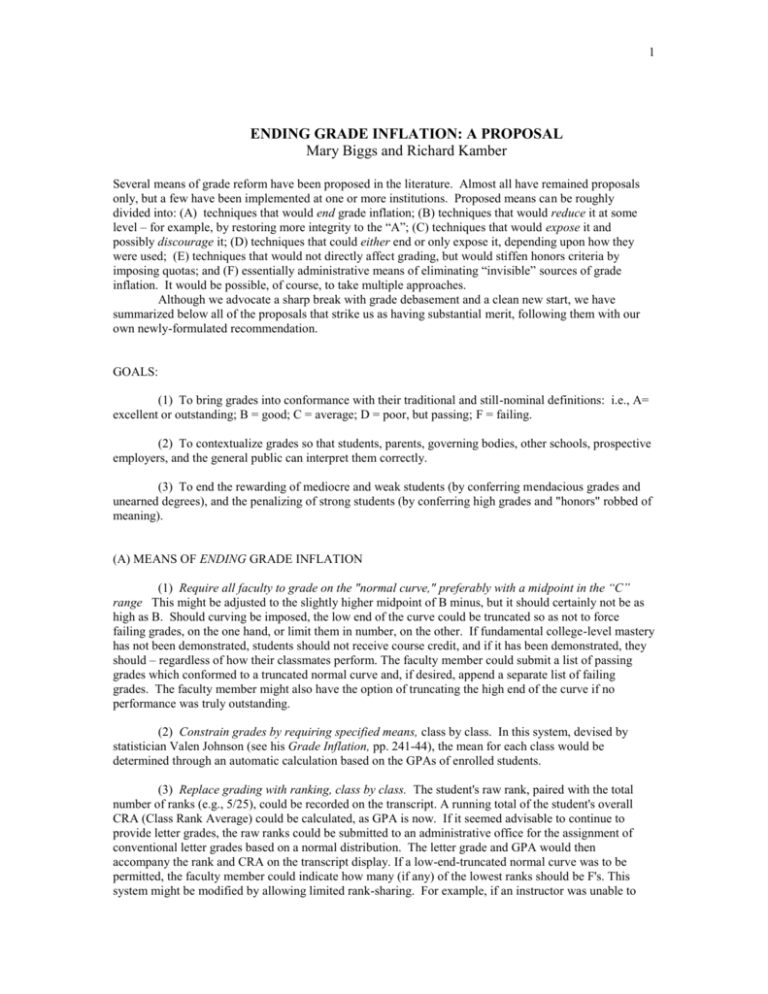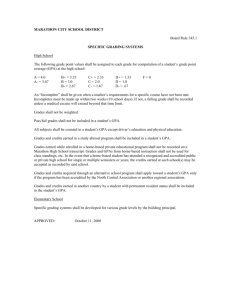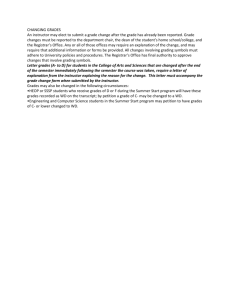ending grade inflation: a proposal
advertisement

1 ENDING GRADE INFLATION: A PROPOSAL Mary Biggs and Richard Kamber Several means of grade reform have been proposed in the literature. Almost all have remained proposals only, but a few have been implemented at one or more institutions. Proposed means can be roughly divided into: (A) techniques that would end grade inflation; (B) techniques that would reduce it at some level – for example, by restoring more integrity to the “A”; (C) techniques that would expose it and possibly discourage it; (D) techniques that could either end or only expose it, depending upon how they were used; (E) techniques that would not directly affect grading, but would stiffen honors criteria by imposing quotas; and (F) essentially administrative means of eliminating “invisible” sources of grade inflation. It would be possible, of course, to take multiple approaches. Although we advocate a sharp break with grade debasement and a clean new start, we have summarized below all of the proposals that strike us as having substantial merit, following them with our own newly-formulated recommendation. GOALS: (1) To bring grades into conformance with their traditional and still-nominal definitions: i.e., A= excellent or outstanding; B = good; C = average; D = poor, but passing; F = failing. (2) To contextualize grades so that students, parents, governing bodies, other schools, prospective employers, and the general public can interpret them correctly. (3) To end the rewarding of mediocre and weak students (by conferring mendacious grades and unearned degrees), and the penalizing of strong students (by conferring high grades and "honors" robbed of meaning). (A) MEANS OF ENDING GRADE INFLATION (1) Require all faculty to grade on the "normal curve," preferably with a midpoint in the “C” range This might be adjusted to the slightly higher midpoint of B minus, but it should certainly not be as high as B. Should curving be imposed, the low end of the curve could be truncated so as not to force failing grades, on the one hand, or limit them in number, on the other. If fundamental college-level mastery has not been demonstrated, students should not receive course credit, and if it has been demonstrated, they should – regardless of how their classmates perform. The faculty member could submit a list of passing grades which conformed to a truncated normal curve and, if desired, append a separate list of failing grades. The faculty member might also have the option of truncating the high end of the curve if no performance was truly outstanding. (2) Constrain grades by requiring specified means, class by class. In this system, devised by statistician Valen Johnson (see his Grade Inflation, pp. 241-44), the mean for each class would be determined through an automatic calculation based on the GPAs of enrolled students. (3) Replace grading with ranking, class by class. The student's raw rank, paired with the total number of ranks (e.g., 5/25), could be recorded on the transcript. A running total of the student's overall CRA (Class Rank Average) could be calculated, as GPA is now. If it seemed advisable to continue to provide letter grades, the raw ranks could be submitted to an administrative office for the assignment of conventional letter grades based on a normal distribution. The letter grade and GPA would then accompany the rank and CRA on the transcript display. If a low-end-truncated normal curve was to be permitted, the faculty member could indicate how many (if any) of the lowest ranks should be F's. This system might be modified by allowing limited rank-sharing. For example, if an instructor was unable to 2 distinguish between the two top students, they might share rank 1, following by a student at rank 3, but none at rank 2. However, rank-sharing should be strictly limited – perhaps to no more than one rank-share per class, or, say, per 25 students – and no more than 2 students should share a rank. (4) Enrich rankings with “percentile” assignments, or use the rankings only to assign students to percentiles. Five or ten percentiles might be calculated. While not as specific as one-by-one rankings, these would still obliterate grade conflation. They also have the advantage of familiarity through SAT and graduating-class percentile rankings. (B) MEANS OF REDUCING GRADE INFLATION Assign quotas to one or more letter-grades, but not to all. Princeton University, for example, has implemented a quota of 35% A’s (to reduce its previous 48% A’s), but has not attacked the other letter grades. Quotas could be enforced at the level of total institution, school, department, faculty member, course, or section. I.e., a quota of 10% A’s could require no more than 10% schoolwide, with some departments allowed a lower percentage overall and some departments a higher percentage; or it could require each faculty member to award no more than 10% A’s per semester or per year, the distribution across courses and sections to be determined by the faculty member; or the quota could simply be applied to each section. Etc. (Princeton has applied the quota at the department level, allowing each department to devise a way of reaching it.) (C) MEANS OF EXPOSING and POSSIBLY DISCOURAGING GRADE INFLATION (1) Grade students and calculate GPAs in the usual way, but add a ranking for each class, and/or a percentile assignment, with running cumulations, as described above in A3. This could disarm any student opposition and alleviate any faculty discomfort, as the customary grades would still be awarded, but the rankings and percentiles would quickly replace the letter grades as authoritative; would provide real comparative information about student performance; and would distinguish excellence from competence from mediocrity from inadequacy. (2) Add value to transcripts by providing comparative information as follows, For example: (a) the median or average grade for each course alongside the student's individual grade: S. Jones Median A B+ and/or: S. Jones A A 15 (b) the grade distribution for each course alongside the student's grade: AB+ B BC+ C CD+ D 3 5 2 0 0 0 0 0 0 F 0 Nothing more can be said of Susan Jones's performance recorded above than that it places her somewhere in the top two-thirds of her class. But the performance below places Susan at the very top of her class, although her two letter grades are identical. S. Jones A A 1 A1 B+ 0 B 3 BC+ 1 1 and/or: C 10 C2 D+ 0 D 4 F 2 (c) on the final transcript, along with the student's individual GPA and GPA within the major, the corresponding median or average GPAs for students in the same graduating class: S. Jones GPA Class GPA S. Jones English GPA Class English GPA 3.6 2.2 3.9 2.5 and/or: 3 (d) as running totals, the number and percentage of courses in which the student has performed above, at, and below the class median or average – e.g.: Above median At median Below median 29 courses 72.5% 10 courses 25% 1 course 2.5% or: (e) all of this, plus more. For example, the Registrar’s Office at Indiana University devised one of the most comprehensive enriched, or value-added, transcripts, which won an EDUCAUSE Best Practices Award. For each course the student took, the transcript displayed nearly all pertinent data that the registrar could extract: instructor’s name, class grade distribution, average class grade, average GPA of students in the class, percentage of majors enrolled, number of withdrawals and when they withdrew, and several more items – alongside the student’s grade. The resulting transcript was too “busy” and confusing to be interpreted easily – added data should be much more carefully selected and clearly formatted – but the project exemplified what could, technically, be done. (3) Calculate and distribute to all faculty members, and publish annually in a readily accessible venue and format, overall institutional, school-by-school, and department-by-department grading data . These could be broken down further to include course-by-course and instructor-by-instructor distributions. While this might, counterproductively, attract some students to the higher-grading departments, grade-hunters always manage to locate these departments. Any negative result could be outweighed by its informational value to the more serious students and the larger community, and by its spur to integrity. (D) MEANS OF EITHER ENDING or ONLY EXPOSING GRADE INFLATION (1) Replace, or enrich, grades with HPS's (Honors Point Scores), in which each course grade is adjusted to reflect the class average (or median) grade. This system, proposed by Noel deNevers in 1984 using averages, would be implemented as follows: (a). The class average is calculated based on a 4-point system. (b). It is subtracted from each student's grade. (c). Whatever grade is considered to be the desirable average is then added to each student’s grade. DeNevers uses 3, or B, but it could be 2 or 2.5, etc. DeNevers suggests that both the grade assigned by the instructor and the Honors Point Score be registered on the transcript, but that Latin honors, Dean's listings, and other academic distinctions be based solely on the Honors Point Score. Latin honors would essentially replace assigned grades as the significant datum and the overall HPS could replace the GPA if a single summative number was still desired. (A more radical application of deNevers's system, which he does not suggest, but which would end grade inflation, would replace the assigned grade with the grade into which the Honors Point Score had been converted) Assume that 3, or B, was used as the desirable average (we would argue for approximately 2.5, however): If a professor's average grade was A, or 4, no student could earn an higher than 3, or equivalent B. A student graded B would earn a 2 (equivalent C). A grade of C would earn a 1, and a D would count for nothing, as would an F. If a class's average grade was B, the would match the grade given by the professor; However, if a professor's average grade was C, an A would earn 5 points (or one point above A), a B 4 points (equivalent A), a C 3, and a D 2. Only the F would not be elevated. (2) Replace, or enrich, the GPA with a Relative Performance Index (RPI), which is closely related, in its intended results, to deNevers's system described above. The RPI, proposed by Brian Nagle in 1998, would index a student's grade, course by course, to those of other students in the same section: (a). The student's grade is converted into quality points (e.g., B=3). (b). The average grade of the other students is converted into quality points. (c). The student's grade is divided by the class average; the quotient is the student's RPI. (A grade that matched the class average would always be 1) 4 (d). A running overall RPI, similar to the currently used overall GPA, is computed and appears on the transcript as well. For example: If the student earned an A and the class average was also A, her RPI would be one. But it would be 1.33 if the class average was B, and a truly impressive 2 if the average was C. On the other hand, if the class average was A and a student was graded C, his RPI would be only .5. If the average was B, it would be .67; and if C, it would be a one. (E) MEANS OF UNDERMINING THE EFFECTS OF GRADE INFLATION Some institutions, notably Harvard, advocate honors reform (Latin honors and possibly Dean’s List designations) rather than direct grading reform. Harvard, for example, proposed limitation of Latin honors to 60% of each graduating class, and summa cum laude designations to 3% - though it is difficult to see how such a fine distinction could be made in a grade-inflated environment. Presumably, a student’s honors status, rather than GPA, would come to be seen as the significant distinction. See also section D above. (F) ELIMINATION OF “INVISIBLE” SOURCES OF GRADE INFLATION Many "reforms" enacted within the past 3-4 decades fuel grade inflation invisibly. These should be reconsidered They include lenient policies regarding: (1) course withdrawals; (2) course re-takes without GPA penalty or other transcript evidence; (3) academic honesty violations; (4) the awarding of “Incomplete” grades; (5) post-semester grade changes; (6) Pass/Fail options; (7) electives relative to requirements. It has also been argued, though on the basis of anecdotal rather than systematic evidence, that the intellectual levels and workloads of many courses have gradually been lowered or reduced. Surveys do reveal that students spend startlingly little time on their coursework despite their overall high grades. WHAT SHOULD BE DONE?: OUR RECOMMENDATIONS (1) SET must be completely overhauled, in general accordance with the recommendations listed in our “Proposal for Reforming Student Evaluations of Teaching (SET) and Peer Evaluations of Teaching (PET)” – also available through this Website. (2) Regardless of how SET is handled, PET should be broadened, toughened, and re-weighted in personnel decision making. (3) The grade-elevating reforms of the past few decades should be re-examined. For example, no legitimate academic purpose is served by allowing students to withdraw from classes more than a few days into the semester; or to take "Incompletes" for reasons other than professionally documented medical or psychological crises; or to submit additional work after semester's end in order to raise a final grade. When a course is retaken, the transcript should say so, and the GPA should incorporate both grades. Academic honesty expectations should be fully detailed in writing, and penalties for proven violations should be severe: at the very least, an ineradicable failing course grade marked with a symbol signifying disciplinary action. An institution committed to building integrity, and restoring credibility to its baccalaureate degrees, will ask other questions as well: perhaps about its course reading, writing, and examination requirements, and the quality and administration of student advisement. 5 (4) Beginning with whichever freshman class will be next to arrive on campus when plans are made, grade inflation can and should be eliminated and an approximate bell-shaped grading curve quickly restored, or an equally informative substitute grading system implemented. We have set forth six possible means of doing this that have been proposed in the literature: (a) by requiring that faculty grade accordingly: (b) by having faculty assign students to a given number of percentiles, designed to result in a bell-shaped curve, rather than grading them; (c) by having faculty rank students rather than grade them – possibly with the ranks then converted administratively to percentiles or to grades distributed on a normal curve; (d) by mandating mean grades, class by class, as recommended by Johnson; (e) by replacing grades with Honors Points Scores, as devised by deNevers; or (f) by replacing grades with Relative Performance Indices, as devised by Brian Nagle. For purposes of institutional reform in the absence of national reform, we favor a ranking system combined with a gently disguised Pass/Fail system. Many students and their parents have become addicted to seeing high grades – preferably A’s – on the transcript each semester. Instead of receiving a P or F for each course, the student would receive an A (for “Achieved credit”) or an F. The institution would have to determine the level of performance required for an A; we believe it should be (an uninflated) C-level. Each faculty member would submit a ranked list of students in each section with rank-sharing either disallowed or very strictly limited (see A3 above). In addition, each student would be graded A or F, both to give students those much-desired A’s and to clarify whether low-ranked students had passed the course. The student’s grade and rank for each course, and a running CRA (Class Rank Average), would be displayed on the transcript along with a boiler-plate explanation. All academic honors would be based on CRAs. The advantages are that: Grade inflation would be eliminated immediately. All students would be fairly treated. Although single inequities might result from enrollment in a class with especially strong or weak students, the full undergraduate record should provide an accurate picture of comparative standing. The faculty would not be required to reorient the way they use letter grading. They would instead grade according to a completely new but simple system – one that would not place them at a disadvantage relative to other faculty or require them to present difficult justifications to students – except, perhaps, when giving an F. The vast majority of students and parents would see the string of A’s that most desire. High schools, law schools, Board scores, etc., already rank students, so the concept is familiar. . For purposes of national reform, we favor the following principles. No more than 20% of undergraduate grades at the A-level (i.e. A+, A, or A- or their equivalents) No more than 50% of undergraduate grades at the A and B levels combined. The grade of F used to indicate failure to meet the standards for a course and not just failure to attend classes or complete assignments.







